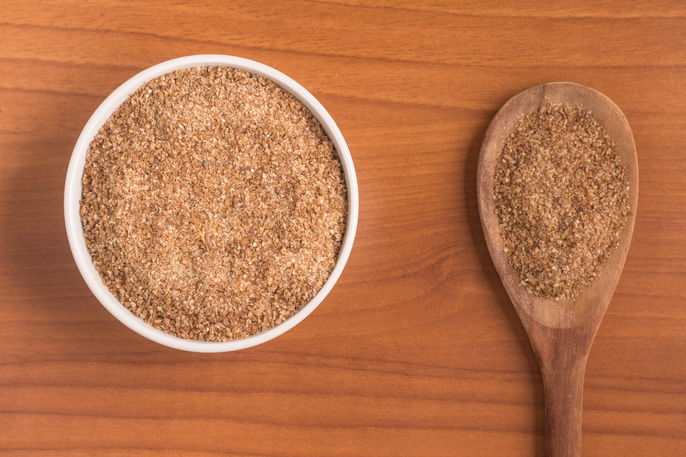Bulgur is a whole grain that is pre-cooked, dried, and crushed. It is high in fiber that improves digestive function and helps support weight loss, prevent diabetes, and lower levels of "bad" cholesterol in the blood.
Bulgur also helps prevent conditions like atherosclerosis and heart attack by decreasing levels of homocysteine in the blood, which is an amino acid linked to cardiovascular disease.
Bulgur can be found in supermarkets in the form of fine or coarse grains and can be used in recipes for kebabs, kofta, bread, meatballs, and tabbouleh.

Health benefits
The main benefits of bulgur include:
1. Relieving constipation
Bulgur is a high-fiber food that helps relieve constipation by increasing stool volume and stimulating gut motility, making it easier to have a bowel movement. See food for constipation.
2. Preventing cardiovascular disease
Bulgur helps prevent cardiovascular disease because it contains betaine, a derivative of the amino acid glycine. Betaine possesses anti-inflammatory and antioxidant properties that help to decrease levels of homocysteine in the blood, an amino acid linked to cardiovascular diseases including atherosclerosis, angina, and heart attack.
3. Supporting weight loss
Bulgur slows down digestion due its high fiber content, which helps promote weight loss by prolonging satiety (the feeling of fullness) and decreasing hunger throughout the day.
Losing weight with bulgur requires maintaining a healthy, well-balanced diet accompanied by regular physical exercise.
4. Preserving eye health
Bulgur is a grain containing lutein and zeaxanthin, which are carotenoids that protect the eyes against free radicals and ultraviolet rays, helping preserve eye health and preventing cataracts as well as macular degeneration, an eye disease that blurs central vision and reduces visual acuity.
5. Lowering "bad" cholesterol
Bulgur helps lower levels of "bad" (LDL) cholesterol in the blood due to its high fiber content that reduces fat absorption in the gut in addition to inhibiting the production of cholesterol in the liver.
6. Decreasing the risk for diabetes
The fiber present in bulgur helps slow down absorption of carbohydrates and keep blood sugar levels under control, protecting against insulin resistance and diabetes.
Also recommended: High Fiber Foods: Food List, Benefits and Types of Fiber tuasaude.com/en/high-fiber-foodsNutrition facts
The following table provides nutritional information for a 100 g serving (about 4 heaping Tbsp) of cooked bulgur:
In order to get all the benefits of bulgur, it is important to include it as one part of a healthy, well-balanced diet in addition to regular physical exercise.
How to eat
Bulgur is used in recipes for kebabs, kofta, bread, meatballs, and tabbouleh, which is a traditional dish with origins in the Middle East.
To make bulgur, add 1/2 cup of bulgur to a saucepan and cover with boiling water, leaving the bulgur to soak up the water for 15 minutes. Drain the excess water and use the bulgur as desired.
Contraindications
Because it contains wheat, bulgur should not be consumed by people with an allergy or intolerance to gluten. People with irritable bowel syndrome (IBS) should also avoid bulgur due to its high fiber content.
Also recommended: IBS Diet (for Symptom Relief): Food Lists, Meal Plan and Expert Tips tuasaude.com/en/ibs-dietHealthy recipes
Examples of healthy and delicious dishes using bulgur include tabbouleh and kebabs.
1. Tabbouleh
Ingredients:
- ½ cup bulgur;
- 2 ripe tomatoes;
- 1 medium onion;
- 1 cucumber;
- Juice of 1 lemon;
- 1 handful fresh mint;
- 1 handful fresh parsley;
- 3 cups boiling water;
- Olive oil, salt, and pepper to taste.
Directions:
Place the bulgur in a saucepan and cover with boiling water. Let rest for 15 minutes then strain using a sieve or dishcloth. Wash the tomatoes and cut in half lengthwise, removing the seeds and chopping the two halves into small cubes. Peel and chop the onion into small cubes.
Chop the cucumber into small cubes. Wash and dry the parsley and mint and finely chop. Combine all the ingredients in a bowl and add the lemon juice, salt, and pepper. Mix well and serve immediately.
2. Baked kebabs
Ingredients:
- ½ cup bulgur;
- 500 g (1 lb) ground beef;
- 3 cups hot water;
- 1 tomato with seeds removed;
- 1 small onion;
- 2 garlic cloves;
- ½ cup fresh mint leaves;
- 2 Tbsp fresh parsley;
- ½ Tbsp salt;
- Pinch of ground cinnamon;
- Olive oil to taste.
Directions:
In a bowl, soak the bulgur in hot water for 15 minutes. Finely chop the onion, garlic, tomato, mint, and parsley. In another bowl, combine the chopped ingredients with the ground beef and spices.
Drain the bulgur and remove the excess water using a sieve or dishcloth. Combine the bulgur with the meat mixture. Grease a baking sheet with olive oil and spread out the kebabs on the baking sheet. Place in a preheated oven at 200°C (400°F) for 35 minutes.






























